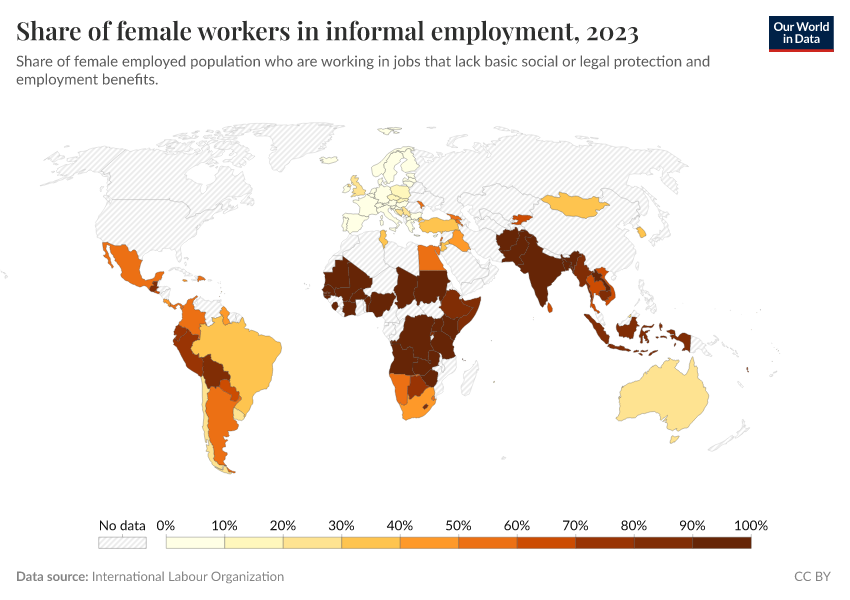Share of female workers in informal employment

What you should know about this indicator
- Employment refers to people of working age who worked for at least an hour during the reference period (typically a week), whether in paid employment or self-employment.
- Informal employment encompasses all jobs that lack basic social or legal protection and employment benefits, regardless of the type of organization in which they are performed. It includes own-account workers, employers, and members of producers’ cooperatives operating in the informal sector; own-account workers engaged in producing goods exclusively for their household’s final use (such as subsistence farming); and contributing family workers, whether in formal or informal sector enterprises. It also covers employees in informal jobs, whether they are working in formal enterprises, informal enterprises, or employed as paid domestic workers by households.
Related research and writing
What you should know about this indicator
- Employment refers to people of working age who worked for at least an hour during the reference period (typically a week), whether in paid employment or self-employment.
- Informal employment encompasses all jobs that lack basic social or legal protection and employment benefits, regardless of the type of organization in which they are performed. It includes own-account workers, employers, and members of producers’ cooperatives operating in the informal sector; own-account workers engaged in producing goods exclusively for their household’s final use (such as subsistence farming); and contributing family workers, whether in formal or informal sector enterprises. It also covers employees in informal jobs, whether they are working in formal enterprises, informal enterprises, or employed as paid domestic workers by households.
Sources and processing
This data is based on the following sources
How we process data at Our World in Data
All data and visualizations on Our World in Data rely on data sourced from one or several original data providers. Preparing this original data involves several processing steps. Depending on the data, this can include standardizing country names and world region definitions, converting units, calculating derived indicators such as per capita measures, as well as adding or adapting metadata such as the name or the description given to an indicator.
At the link below you can find a detailed description of the structure of our data pipeline, including links to all the code used to prepare data across Our World in Data.
Reuse this work
- All data produced by third-party providers and made available by Our World in Data are subject to the license terms from the original providers. Our work would not be possible without the data providers we rely on, so we ask you to always cite them appropriately (see below). This is crucial to allow data providers to continue doing their work, enhancing, maintaining and updating valuable data.
- All data, visualizations, and code produced by Our World in Data are completely open access under the Creative Commons BY license. You have the permission to use, distribute, and reproduce these in any medium, provided the source and authors are credited.
Citations
How to cite this page
To cite this page overall, including any descriptions, FAQs or explanations of the data authored by Our World in Data, please use the following citation:
“Data Page: Share of female workers in informal employment”. Our World in Data (2025). Data adapted from International Labour Organization. Retrieved from https://auto-epoch.owid.pages.dev:8789/20250926-154625/grapher/share-in-informal-employment-female.html [online resource] (archived on September 26, 2025).How to cite this data
In-line citationIf you have limited space (e.g. in data visualizations), you can use this abbreviated in-line citation:
International Labour Organization – with minor processing by Our World in DataFull citation
International Labour Organization – with minor processing by Our World in Data. “Share of female workers in informal employment” [dataset]. International Labour Organization, “Data from multiple sources” [original data]. Retrieved November 1, 2025 from https://auto-epoch.owid.pages.dev:8789/20250926-154625/grapher/share-in-informal-employment-female.html (archived on September 26, 2025).